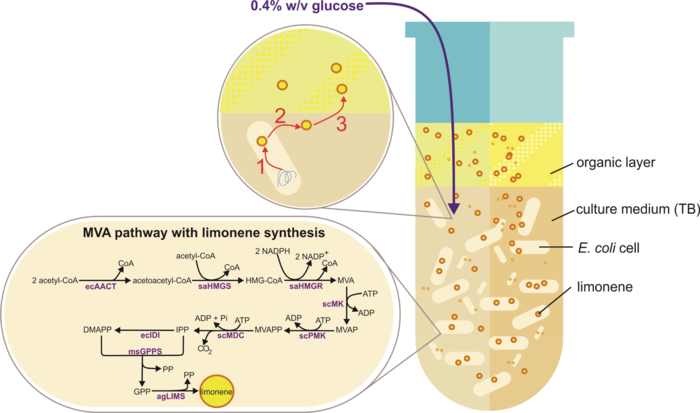Mevalonate pathway with limonene synthesis

Limonene is a major constituent in essential oils and is diversely used in pharmaceuticals, flavourings, fragrances, antimicrobials, pesticides and household products. Experimentally, the mevalonate pathway has been successfully employed in microbial hosts for the production of terpenes such as limonene. Computational modelling of this heterologous limonene production system could provide further insights into potential pathway engineering strategies to further improve the production of this compound and its derivatives. In this study, we have modelled the biosynthesis of limonene in Escherichia coli using a newly-established ensemble modelling approach. Here we present the construction, parameterisation, simulation and initial analysis of this ensemble model and discuss its application for pathway optimization.
Our limonene synthesis models describes:
- 1 Production of limonene via the MVA pathway
- 2 Secretion of limonene out of the cell into the medium
- 3 Sequestration of limonene into the organic layer
Contents
Mevalonate pathway models
We have two MVA pathway models. Both models describe the synthesis of limonene, but one is more detailed than the other. In the basic MVA model, the enzyme concentrations are set as fixed concentrations whereas in the improved MVA model, the enzyme concentrations are not fixed and its degradation is taken into account. A detailed description of these models along with the simulations and analysis that were carried out can be accessed by clicking on the buttons below.
Preliminary MVA pathway model Basic mevalonate pathway model with limonene synthesis: Construction and Ensemble analysis
Mevalonate pathway reactions
| Modelling growth and culture conditions
Common reactions
|
|
Parameterisation
Parameterisation for all of the MVA models here are according to our DIPPER protocol with the DipperXBrenda add-on.
General weighting scheme used in this model
| Categories | Subcategories | Description | Weight value |
|---|---|---|---|
| Method | In vivo | Ideal parameter value measurement condition (i.e. measurement condition matches the modelling system) | 4 |
| In vitro | Parameter value was measured in vitro, and does not match our modelling system but the values are still useful. | 1 | |
| Organism | Identical | The ideal organism source where the enzyme is characterised from is the same gene used in the recombinant plasmid used in the model, i.e. M. spicata, E. coli | 4 |
| Related | The organism from which the enzyme is characterised is an organism which is phylogenetically related to gene of interest | 2 | |
| Unrelated | The organism from which the enzyme is characterised is not E. coli and not phylogenetically related to gene of interest | 1 | |
| Enzyme class | Identical | Ideal EC would be EC 4.2.3.16, which is the exact EC for limonene synthase. | 4 |
| Related | This is chosen when the parameter value is found for the same class or subclass as the modelled enzyme. In this case study example, values from EC 4.*.*.* or EC 4.3.2.* would be assigned to this weighting subcategory. | 2 | |
| Different | This is for parameter values originating from enzymes with a completely different enzyme class. The value would still be useful in cases where parameter values for a certain enzyme is hard to find and the modeller can look for information from other enzymes (e.g. there are values found for the kinetics of a substrate of interest but with a different enzyme). | 1 | |
| pH | Identical | Ideal pH that matches the modelling system. In this case study example, it is pH 7.5. | 4 |
| Similar | This is chosen for when the pH determined during kinetic evaluation is close to our ideal pH. In this case study example, we deemed a pH value within ± 0.5 from the ideal 7.5 as similar (i.e. pH 7.0 and pH 8.0). | 2 | |
| Different | This is chosen when the pH is different from the two subcategories described above. | 1 | |
| Temperature | Identical | Ideal temperature that matches the modelling system. In this case study example, the ideal temperature is 30°C. | 4 |
| Similar | As in the same subcategory for pH, this is chosen when the temperature is within ±0.5 from the ideal value (i.e. 25°C and 35°C) | 2 | |
| Different | This is chosen when the temperature during measurement is different from the two subcategories described above. | 1 |

